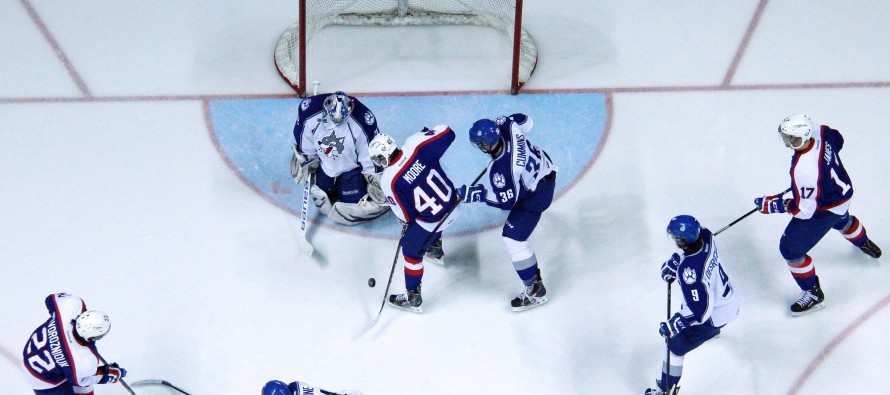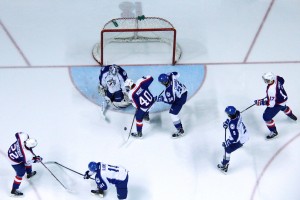Transition to junior hockey is a difficult one


Windsor Spitfires rookie forward Ryan Moore, battles for a rebound during third period action against the Sudbury Wolves at the WFCU Centre Jan. 19. The Spitfires would eventually win 3-1. (Photo by/Evan Mathias)
by Evan Mathias
Almost every Canadian hockey player grows up dreaming to play in the NHL, to play hockey at the highest level for their favourite team.
For many of these kids that dream will never be achieved, for some however, they have the skill necessary to play at a level of hockey high enough to be drafted into major-junior hockey in one of the three Canadian Hockey League teams
For these players this is just one step closer to their final goal, the NHL. These players though, might not initially realize how different playing junior hockey is compared to the minor hockey they have grown up playing all their lives.
Everything about the game changes when you make that jump from AAA hockey into the OHL. Hockey is no longer just about having fun. The OHL is a business and teams expect their players to perform at a level that brings success to the team. As a player you are also expected to be mature and act professional so as not to bring negative media attention towards the organization you play for.
Andrew Sykes, owner of the Windsor-Essex Hockey Prospectus Website and scout for TheScout.ca said players who come into the OHL straight from minor-midget hockey need to adjust to a variety of things, with one of the main adjustments being the business mentality of the OHL.
“In minor-midget the player experiences some pressure of the OHL Draft and coaches that are fairly demanding, but it is still very much a fun season and not nearly as demanding as junior,” said Sykes. “In junior you are expected to be entirely focused on hockey. Focused on your workouts, every day at practice and every game.”
Rob Benneian, marketing coordinator of the LaSalle Vipers sees the transition into a business world differently for players making the jump into junior hockey. He said that many already understand much of the business side and what it means to be a professional athlete.
“I think young hockey players who have an eye on making a living in the sport learn early on that its a business so that isn’t that big a difference at the junior level,” said Benneian. “They all already have agents and treat it like a job if they are serious about advancing. Competitive midget hockey is as much a business as anything.”
Despite minor-midget hockey being a business, there is no comparison to being under the eye of the media almost 24/7 and being under public scrutiny every game if you are under performing. Many players are unable to overcome that pressure and are unable to successfully advance at the OHL or Junior B levels.
The added pressure of a business world isn’t the biggest difficulty for players coming into the OHL according to Sykes. He said there are two main challenges and differences for players to adjust to, the first being on-ice differences.
“On the ice the most obvious difference is the gap in age,” said Sykes. “Not only are you playing against older players who are much stronger and more physically matured, but also those same players are also the best of the best and have so much more experience on their side. Junior hockey is a constant learning experience and it takes a special talent to come in and excel as a rookie.”
The second difference generally has nothing to do with being on the ice.
“The other part is the off-ice changes. Most have to move away from home, which is difficult in itself. Add in having to balance hockey, school and an incredibly compressed schedule makes it a massive change from what they would be used to. It requires a young person to mature mentally and emotionally very quickly to be able to take it all in.”
What about those off-ice difficulties though, the difficulties that can’t just be overcome by hard work and practicing more. Difficulties like leaving your family and friends that you have grown up with your whole life for eight or more months out of the year, very seldom getting to visit. The challenge of moving in with a new billet family that players live with, often for the duration of their junior hockey careers is just as difficult as learning the new style of game on the ice. The off ice impacts might actually be the ones that are more difficult for players to adapt to, because they are things that they may not have expected or thought about as much when they were drafted into the OHL. The level of maturity expected of these players to just make a jump to a new league, a new life and just leave their old one behind can be baffling. Sykes said there isn’t really any way for these players to prepare for this transition and that for a lot of players whether they think they are prepared or not, it doesn’t really hit them until the change actually happens and they are living away from the family and friends that they depended on so much, just weeks or months before.
Sykes did say though that there are some players who make seamless transitions into the junior hockey lifestyle despite moving away from home.
“The players that can easily make the transition have to have a high level of maturity both on and off the ice. They have to be able to adapt to situations and circumstances and meet any challenges head on with a clear head,” said Sykes.
The players, who can overcome this challenge of junior hockey, can often endure another challenge, the pressure of the league and the expectations of the coaches and team management.
There are some cases where players are able to make the adjustment of living away from home during their junior hockey career because they have already experienced a similar adjustment.
“Living away from home for the first time can be a big adjustment but at the same time a lot of these kids are moving away from home long before junior hockey teams come calling, whether its at a prep school or they move from their hometown to a better minor hockey market where they will have more eyes on them,” said Benneian. “They have to learn to deal with the pressure at a young age.”
These players who can make the move to a new city without many issues are often better on the ice because they are not worrying about their off-ice life. They can focus on hockey without many outside distractions.
“I think players who have experienced that already, by going to a prep school or moving to a bigger market away from your family, are ahead of the game and come out better for it.”
Two members of the Windsor Spitfires have recently made the transition from minor hockey into the OHL. Forward Josh Ho-Sang was drafted fifth overall in 2012 by Windsor and Ryan Moore was drafted in the second round this season. Both had troubles transitioning into the OHL. For Ho-Sang it was a matter of letting go of his ego he obtained from being a dominant force on his minor-midget AAA team.
“At the start of last year I was very hard headed and I’ll be the first to admit that,” said Ho-Sang. “but this year I’m really buying in to what (head coach Bob Boughner) is saying and I really believe in our coaches and our team and I know we can go far.”
Sykes said it is not uncommon for players at young ages who are stars to develop egos, but that mindset can come back to bite you when you begin playing at higher levels of hockey.
Ho-Sang grew up just outside Toronto so for him moving from a big city to a smaller market like Windsor was something he had to get used to.
Moore also grew up in a bigger market, Troy Mich. He said that Troy is bigger and busier than where he is being billeted in Tecumseh. For him a lot of the challenges he deals with come on the ice. Not because of skill level, but because of size.
“Coming in as a rookie is tough, 16-years-old coming in the league and you’re playing against men,” said Moore.
Balancing school and practice almost everyday was difficult for Moore but he says he has gotten used to the full schedule he has every week.
Sykes said there are exceptions to the rule, but in most cases players coming into the OHL have to go through the learning process and develop their game.
“Most players who advance to the junior level were generally pretty successful in minor hockey,” said Sykes. “The elite talents can come in and excel right away but those of course are few and far between. Most players will have to undertake a progression curve where they are constantly working to improve.”
“That player can either let the frustration of going through early struggles get the best of them, or they can cite it as needing to work hard every day, learn more every day, and get better.”
No matter what way you look at it, junior hockey is a challenge for all players. Some are better able to cope with the hardships and face the challenges head on. The ones who are able to do that and come out successfully in their junior career are often able to make the jump to the next level. Despite the challenges that go along with junior hockey it is a lifestyle that players would never give up and is one that kids grow up dreaming about.


